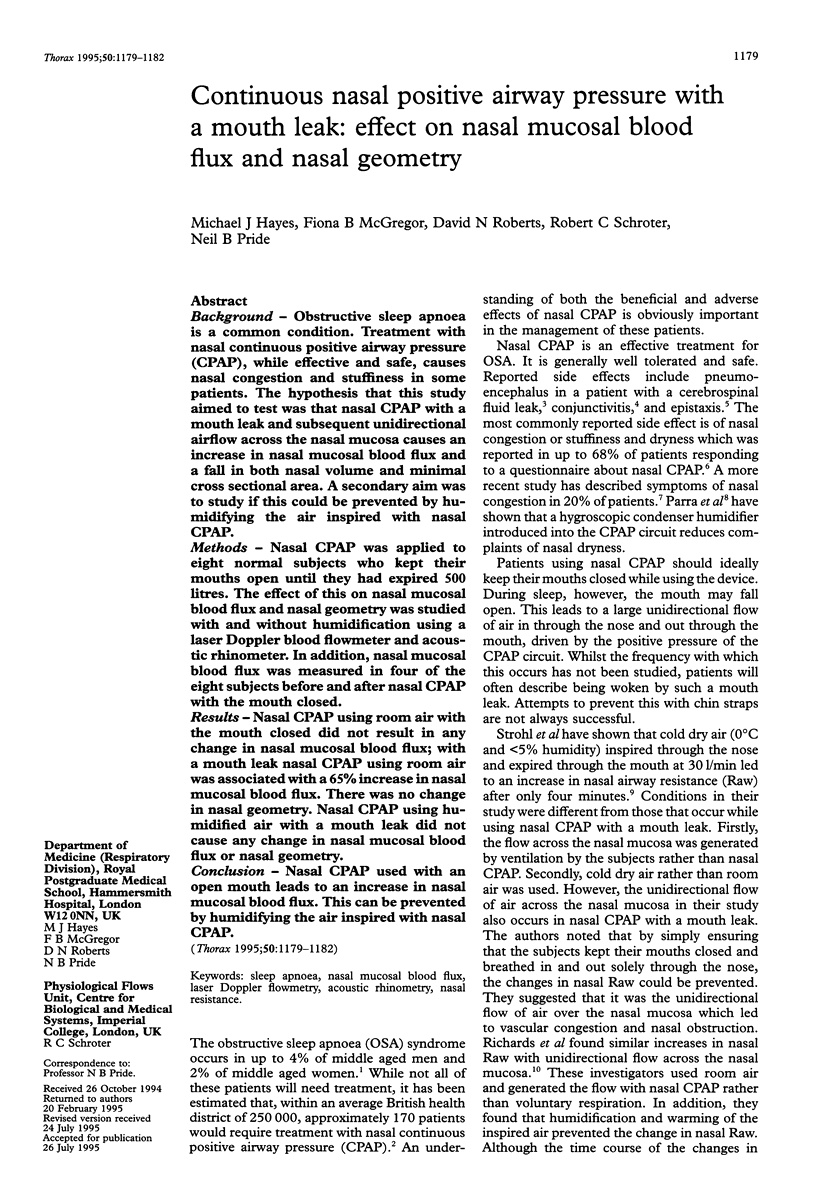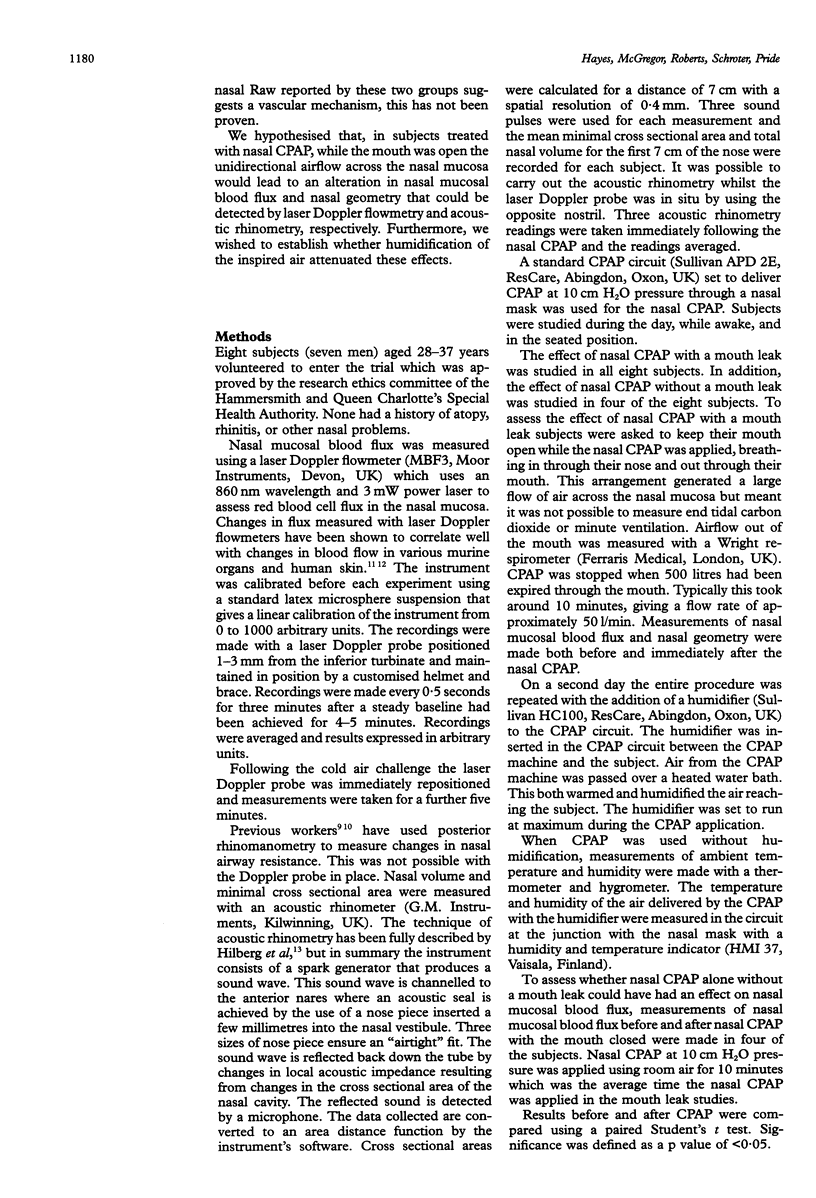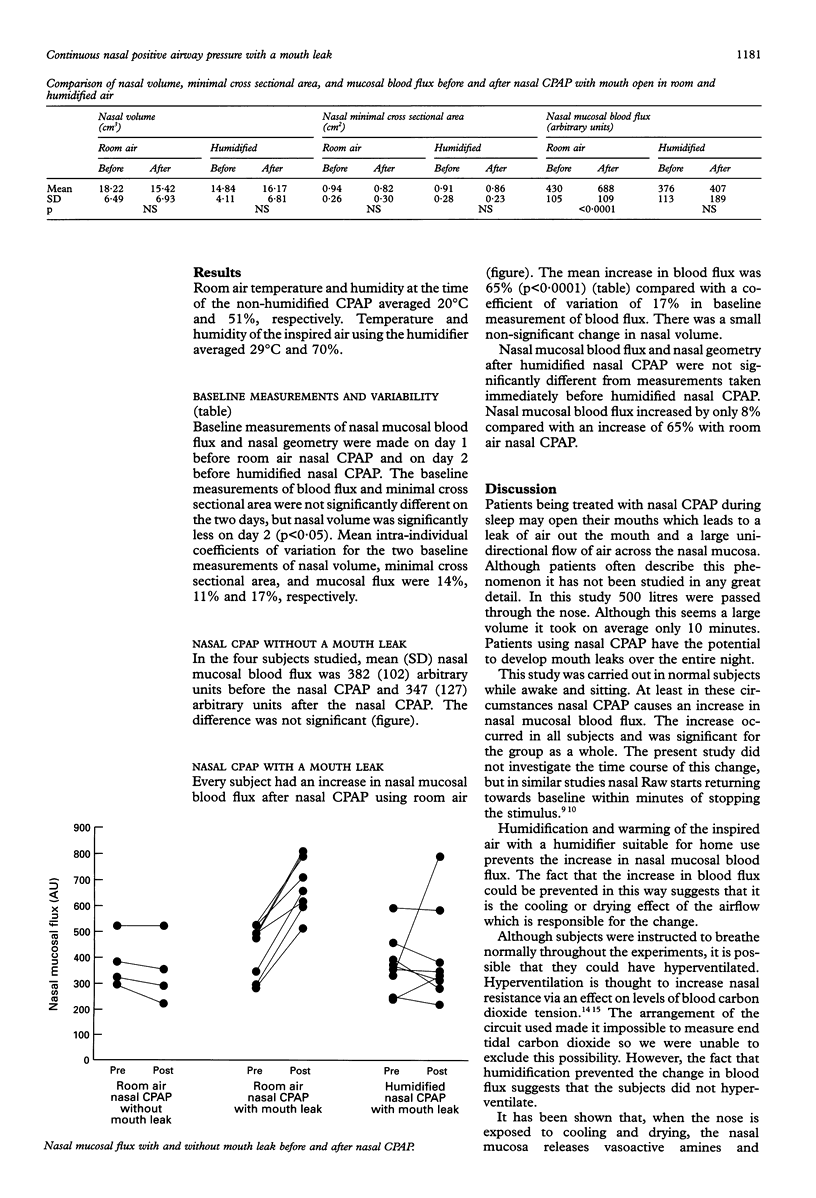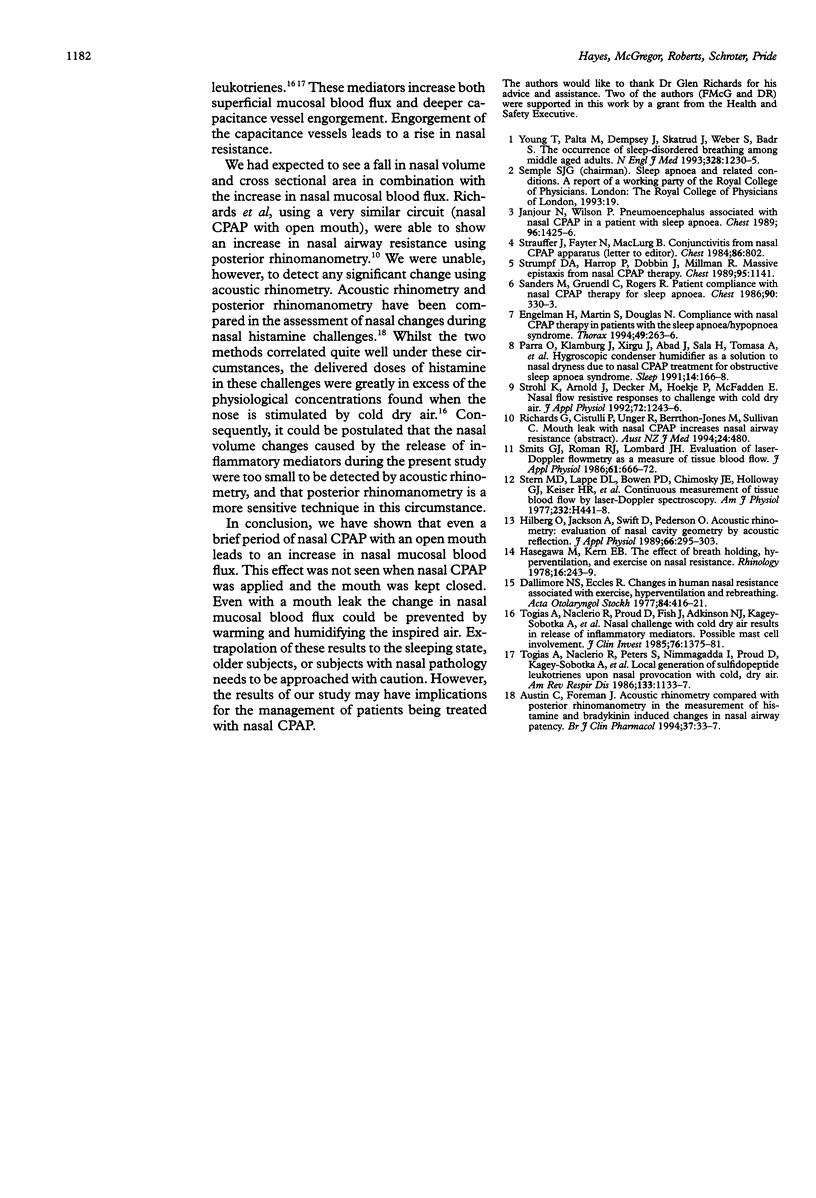Abstract
BACKGROUND--Obstructive sleep apnoea is a common condition. Treatment with nasal continuous positive airway pressure (CPAP), while effective and safe, causes nasal congestion and stuffiness in some patients. The hypothesis that this study aimed to test was that nasal CPAP with a mouth leak and subsequent unidirectional airflow across the nasal mucosa causes an increase in nasal mucosal blood flux and a fall in both nasal volume and minimal cross sectional area. A secondary aim was to study if this could be prevented by humidifying the air inspired with nasal CPAP. METHODS--Nasal CPAP was applied to eight normal subjects who kept their mouths open until they had expired 500 litres. The effect of this on nasal mucosal blood flux and nasal geometry was studied with and without humidification using a laser Doppler blood flowmeter and acoustic rhinometer. In addition, nasal mucosal blood flux was measured in four of the eight subjects before and after nasal CPAP with the mouth closed. RESULTS--Nasal CPAP using room air with the mouth closed did not result in any change in nasal mucosal blood flux; with a mouth leak nasal CPAP using room air was associated with a 65% increase in nasal mucosal blood flux. There was no change in nasal geometry. Nasal CPAP using humidified air with a mouth leak did not cause any change in nasal mucosal blood flux or nasal geometry. CONCLUSION--Nasal CPAP used with an open mouth leads to an increase in nasal mucosal blood flux. This can be prevented by humidifying the air inspired with nasal CPAP.
Full text
PDF



Selected References
These references are in PubMed. This may not be the complete list of references from this article.
- Austin C. E., Foreman J. C. Acoustic rhinometry compared with posterior rhinomanometry in the measurement of histamine- and bradykinin-induced changes in nasal airway patency. Br J Clin Pharmacol. 1994 Jan;37(1):33–37. doi: 10.1111/j.1365-2125.1994.tb04235.x. [DOI] [PMC free article] [PubMed] [Google Scholar]
- Dallimore N. S., Eccles R. Changes in human nasal resistance associated with exercise, hyperventilation and rebreathing. Acta Otolaryngol. 1977 Nov-Dec;84(5-6):416–421. doi: 10.3109/00016487709123985. [DOI] [PubMed] [Google Scholar]
- Engleman H. M., Martin S. E., Douglas N. J. Compliance with CPAP therapy in patients with the sleep apnoea/hypopnoea syndrome. Thorax. 1994 Mar;49(3):263–266. doi: 10.1136/thx.49.3.263. [DOI] [PMC free article] [PubMed] [Google Scholar]
- Hasegawa M., Kern E. B. The effect of breath holding, hyperventilation, and exercise on nasal resistance. Rhinology. 1978 Dec;16(4):243–249. [PubMed] [Google Scholar]
- Hilberg O., Jackson A. C., Swift D. L., Pedersen O. F. Acoustic rhinometry: evaluation of nasal cavity geometry by acoustic reflection. J Appl Physiol (1985) 1989 Jan;66(1):295–303. doi: 10.1152/jappl.1989.66.1.295. [DOI] [PubMed] [Google Scholar]
- Jarjour N. N., Wilson P. Pneumocephalus associated with nasal continuous positive airway pressure in a patient with sleep apnea syndrome. Chest. 1989 Dec;96(6):1425–1426. doi: 10.1378/chest.96.6.1425. [DOI] [PubMed] [Google Scholar]
- Parra O., Klamburg J., Xirgu J., Abad J., Sala H., Tomasa A., Morera J. Hygroscopic condenser humidifier as a solution to nasal dryness due to nasal CPAP treatment for obstructive sleep apnea syndrome. Sleep. 1991 Apr;14(2):166–168. doi: 10.1093/sleep/14.2.166. [DOI] [PubMed] [Google Scholar]
- Sanders M. H., Gruendl C. A., Rogers R. M. Patient compliance with nasal CPAP therapy for sleep apnea. Chest. 1986 Sep;90(3):330–333. doi: 10.1378/chest.90.3.330. [DOI] [PubMed] [Google Scholar]
- Smits G. J., Roman R. J., Lombard J. H. Evaluation of laser-Doppler flowmetry as a measure of tissue blood flow. J Appl Physiol (1985) 1986 Aug;61(2):666–672. doi: 10.1152/jappl.1986.61.2.666. [DOI] [PubMed] [Google Scholar]
- Stauffer J. L., Fayter N., MacLurg B. J. Conjunctivitis from nasal CPAP apparatus. Chest. 1984 Nov;86(5):802–802. doi: 10.1378/chest.86.5.802a. [DOI] [PubMed] [Google Scholar]
- Stern M. D., Lappe D. L., Bowen P. D., Chimosky J. E., Holloway G. A., Jr, Keiser H. R., Bowman R. L. Continuous measurement of tissue blood flow by laser-Doppler spectroscopy. Am J Physiol. 1977 Apr;232(4):H441–H448. doi: 10.1152/ajpheart.1977.232.4.H441. [DOI] [PubMed] [Google Scholar]
- Strohl K. P., Arnold J. L., Decker M. J., Hoekje P. L., McFadden E. R. Nasal flow-resistive responses to challenge with cold dry air. J Appl Physiol (1985) 1992 Apr;72(4):1243–1246. doi: 10.1152/jappl.1992.72.4.1243. [DOI] [PubMed] [Google Scholar]
- Strumpf D. A., Harrop P., Dobbin J., Millman R. P. Massive epistaxis from nasal CPAP therapy. Chest. 1989 May;95(5):1141–1141. doi: 10.1378/chest.95.5.1141. [DOI] [PubMed] [Google Scholar]
- Togias A. G., Naclerio R. M., Peters S. P., Nimmagadda I., Proud D., Kagey-Sobotka A., Adkinson N. F., Jr, Norman P. S., Lichtenstein L. M. Local generation of sulfidopeptide leukotrienes upon nasal provocation with cold, dry air. Am Rev Respir Dis. 1986 Jun;133(6):1133–1137. doi: 10.1164/arrd.1986.133.6.1133. [DOI] [PubMed] [Google Scholar]
- Togias A. G., Naclerio R. M., Proud D., Fish J. E., Adkinson N. F., Jr, Kagey-Sobotka A., Norman P. S., Lichtenstein L. M. Nasal challenge with cold, dry air results in release of inflammatory mediators. Possible mast cell involvement. J Clin Invest. 1985 Oct;76(4):1375–1381. doi: 10.1172/JCI112113. [DOI] [PMC free article] [PubMed] [Google Scholar]
- Togias A. G., Naclerio R. M., Proud D., Fish J. E., Adkinson N. F., Jr, Kagey-Sobotka A., Norman P. S., Lichtenstein L. M. Nasal challenge with cold, dry air results in release of inflammatory mediators. Possible mast cell involvement. J Clin Invest. 1985 Oct;76(4):1375–1381. doi: 10.1172/JCI112113. [DOI] [PMC free article] [PubMed] [Google Scholar]
- Young T., Palta M., Dempsey J., Skatrud J., Weber S., Badr S. The occurrence of sleep-disordered breathing among middle-aged adults. N Engl J Med. 1993 Apr 29;328(17):1230–1235. doi: 10.1056/NEJM199304293281704. [DOI] [PubMed] [Google Scholar]


